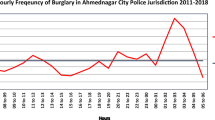Abstract
Geo-Informatic Tupu is a complex spatio-temporal analysis method. Its detailed, simple image analysis and expression ways can be better meet the crime spatio-temporal analysis needs. This paper summarizes the research background and current situation of crime spatio-temporal analysis, and discusses the significance and content of this research. And also this paper puts forward own ideas about research ways, which is in order to provide a new method for method references and decision supports in the crime spatio-temporal analysis practices.
Similar content being viewed by others
References
Chen, W., Wu, J.P.: Research review on temporal and spatial distribution of foreign criminal. World Reg. Stud. 22(2), 151–158 (2013)
Herold, M., Couclelis, H., Clarke, K.C.: The role of spatial metrics in the analysis and modeling of urban land use change. Comput. Environ. Urban Syst. 29, 369–399 (2005)
Irwin, E., Geoghegan, J.: Theory, data, methods: developing spatially-explicit economic models of land use change. Agric. Ecosyst. Environ. 85, 7–24 (2001)
Liu, W., Seto, K.C., Sun, Z.: An ART-MMAP neural network based spatio-temporal data mining approach to predict urban growth[OB/OL] (2006). http://www.isprs.org/commission8/workshop_urban
White, R., Engelen, G.: The use of constrained cellular automata for high-resolution modeling of urban landuse dynamics. Environ. Plann. B: Plann. Des. 24, 323–343 (1997)
Pijanowski, B.C., Pithadia, S., Shellito, B.A., et al.: Calibrating a neural network-based urban change model for two metropolitan areas of the upper midwest of the United States. Int. J. Geogr. Inf. Sci. 19(2), 197–215 (2005)
Ridd, M., Liu, J.: A comparison of four algorithms for change detection in an urban environment. Remote Sens. Environ. 63, 95–100 (1998)
Schneider, L.C., Pontius, R.G.: Modeling land-use change in the Ipswich Watershed, Massachusetts, USA. Agric. Ecosyst. Environ. 85, 83–94 (2001)
Batty, M.: Agents, cells, and cities: new representational models for simulating multi scale urban dynamics. Environ. Plann. A 37(8), 1373–1394 (2005)
Verburg, P.H., Veldkamp, A., Bouma, J.: Land use change under conditions of high population pressure: the case of Java. Glob. Environ. Change 9, 303–312 (1999)
White, R., Engelen, G., Uljee, I., et al.: Developing an urban land use simulator for European Cities. In: Fullerton, K. (ed.) Proceedings of the 5th EC GIS Workshop: GIS of Tomorrow, European Commission Joint Research Centre, pp. 179–190 (2000)
Acknowledgements
This work was financially supported by the Priority Academic Program Development of Jiangsu Higher Education Institutions, the Natural Science Foundation of Jiangsu Province No. BK20141033, the Theory and the Soft Science Project of Ministry of Public Security No. 2014LLYJJSST061, the University Science Research Surface Project of Jiangsu Province No. 13KJB420002, the University Philosophy and Social Sciences Research Project of Jiangsu Province No. 2014SJD194 and the Research Project of Jiangsu Police Institute No. 13Q18.
Author information
Authors and Affiliations
Corresponding author
Editor information
Editors and Affiliations
Rights and permissions
Copyright information
© 2016 Springer-Verlag Berlin Heidelberg
About this paper
Cite this paper
Cai, D., Chen, Y., Gao, C. (2016). Primary Research on Geo-Informatic Tupu for Crime Spatio-Temporal Analysis. In: Bian, F., Xie, Y. (eds) Geo-Informatics in Resource Management and Sustainable Ecosystem. GRMSE 2015. Communications in Computer and Information Science, vol 569. Springer, Berlin, Heidelberg. https://doi.org/10.1007/978-3-662-49155-3_62
Download citation
DOI: https://doi.org/10.1007/978-3-662-49155-3_62
Published:
Publisher Name: Springer, Berlin, Heidelberg
Print ISBN: 978-3-662-49154-6
Online ISBN: 978-3-662-49155-3
eBook Packages: Computer ScienceComputer Science (R0)




